On 27th May Glasgow City Council applied for planning permission to itself for a new car park, road and footpath as part of the Transforming Pollok Country Park Project (see here for planning papers) and in anticipation of higher visitor numbers to the Burrell once the refurbishment/expansion is complete.
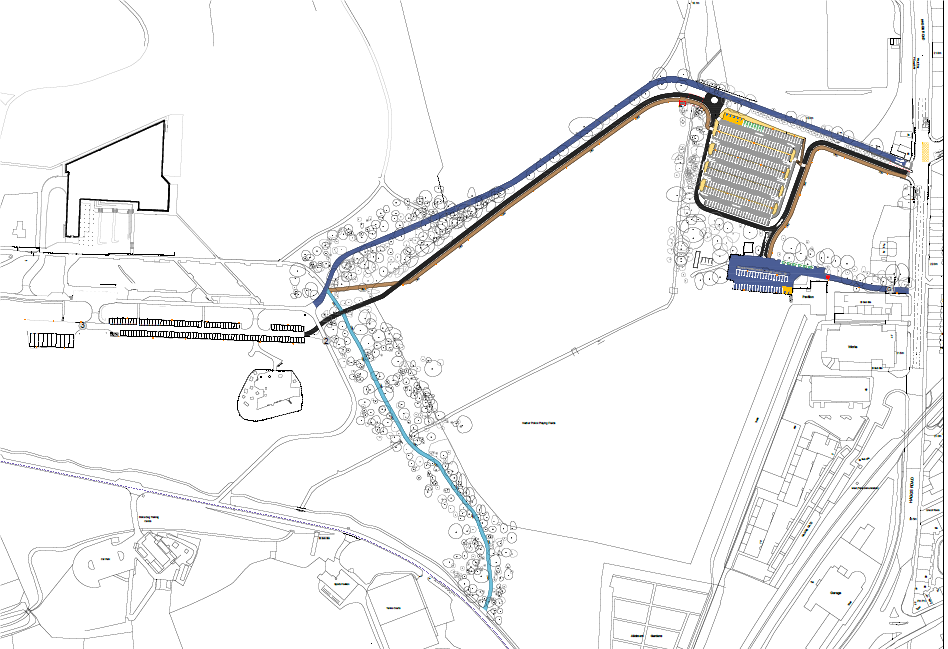
Key: blue = existing road upgraded; black = new road; brown = new footpath; light blue – existing footpath upgraded to disability standards. All illustrations courtesy of GCC Planning Portal.
The application form is not entirely clear but planning consent appears to being applied for:
- a new car park for 277 vehicles on the existing unused Nether Pollok blaes pitch by Hagg’s Road
- widening of the Hagg’s Road exit to form an entrance/exit
- creation of a new road to the Burrell car park and
- installation of various car barriers to limit vehicular access elsewhere in the Park.
The application is open for comment until 6th July and you can do so on the online planning portal above or at end of this blog.
The declared purpose of the application is to reduce the circulation of traffic in Pollok Country Park. It is part of a wider active travel plan accompanying the re-development of the Burrell. The Application contains a report of Glasgow City Council’s engagement with stakeholders that took place in 2019. Since then, as a result of Covid-19, the world and Pollok Country Park have changed beyond recognition.
More specifically the closure of Pollok Park to vehicles during the lockdown and the large numbers of people accessing the park by foot or by bike has transformed ideas of what might be possible. The proposals now look very dated and it is regrettable that Glasgow City Council has not re-considered them before submitting the planning application.
How does the new car park deliver policy objectives?
There is almost nothing in the Planning Application about climate breakdown or air quality and how encouraging cars back to Pollok Park will meet either of these objectives. Pollok Country Park has become, as a result of the corona crisis, an exemplar for active travel and clean air in Glasgow.
What’s more, since the closure of Pollok Park to vehicles, both the number and the diversity of people using the park has increased considerably. This is despite Pollok being one of the less accessible parks in Glasgow for those without cars. People are now walking and cycling considerable distances to get to the park, despite the lack of connecting cycle lanes. It appears too that the more people have used the park, the more people feel safe. It is now, for example, not uncommon to see women from the BAME communities walking alone in the park, something that very rarely happened before Covid-19. The number of BAME people using the park is now far more representative of the population on the Southside than it was previously and there are lots of other people using the park regularly for the first time. A welcome transformation
There are, however, two groups that appear to have been under-represented in the park during the corona crisis, older people and people with physical disabilities. This may be partly a consequence of government advice to those two groups to isolate and shield, but also appears to be because Pollok Park is very difficult to access for people with reduced mobility except by car when there has been no public transport. No provision has been allowed for disabled parking within the park during the time it has been shut to vehicles.
Proposals for roads and vehicular access
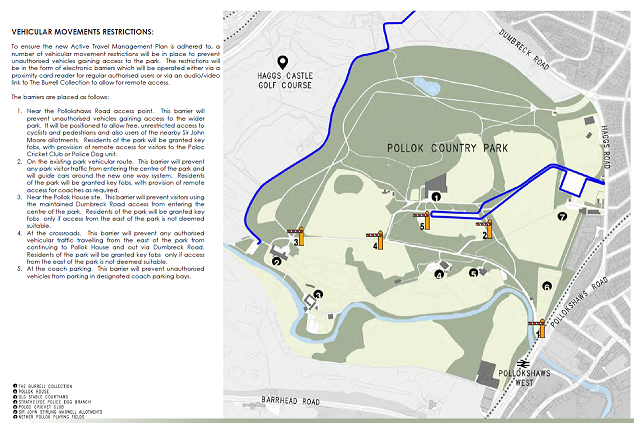
Key. Blue = access road and traffic circulation. Number yellow symbols = barriers.
The idea is to stop cars circulating through Pollok Park and replace current arrangements with two vehicular access points where vehicles can drive to the Burrell and Pollok House and then return. It is also proposed to run a 15 minute electric shuttle bus from Pollokshaws Rd, via Pollok House and the Burrell to Haggs Rd. That raises the question why it is necessary to keep any road open for the general public, apart from those with mobility problems who might need not be able to use the bus? Why not continue the general ban on vehicles? If record numbers of Glasgow residents are now visiting the park on foot and bike, why couldn’t tourists do that too, particularly once public transport re-opens?
If the shuttle buses were extended to the Dumbreck entrance, almost all the park and the two main visitor attractions would be accessible for those wanting only to walk short distances and links to public transport would be improved. In a post-Covid world, a more radical and greener solution then the current would be to remove all vehicles used by the general public from the park except for those used by people with mobility problems.
Vehicular access would, of course, need to be maintained for people resident in the park and those needing to access it for specific purposes. These include staff and volunteers (who are often older people) working with the National Trust for Scotland at Pollok House, the sports clubs, allotment holders, the police and City staff and contractors working in the park. The installation of barriers and the instigation of a pass system would enable all these groups to continue to use vehicles to access the park.
Unfortunately the presumption behind the application appears to be that it is vehicular access which counts:
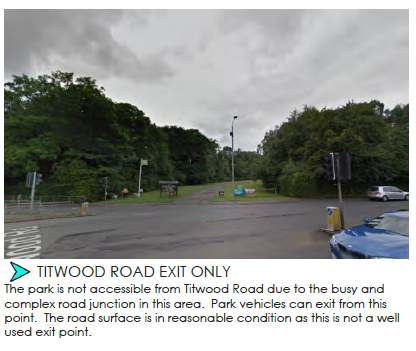
This is wrong. Pollok Country Park is very accessible from the Titwood Rd/St Andrew’s Drive entrance but to walkers and cyclists not cars. It is been used by thousands of people during the lockdown to access the park and work to improve the junction for cyclists, as part of the extension of the South West City cycle way, appears to have just started.
The Planning Application states that even if vehicular circulation within the park is reduced “it was still necessary upgrade entry points to cope with to cope with the predicted visitor number increase as a result of the reopening of The Burrell Collection”, i.e the presumption is that people “need” to arrive at the Burrell by car. The response of people to the corona crisis has overturned that presumption.
With the introduction of a shuttle bus, Pollok Country Park would be well served from Pollokshaws West railway station and a number of bus routes. If the Shuttle bus also went to the Dumbreck “entrance”) there is a good path connection to Dumbreck station 10 minutes walk away.
What car parking is proposed and what is needed?
The Application presents the proposals as involving a considerable reduction in parking and therefore green. It is not an accurate description of the current situation.
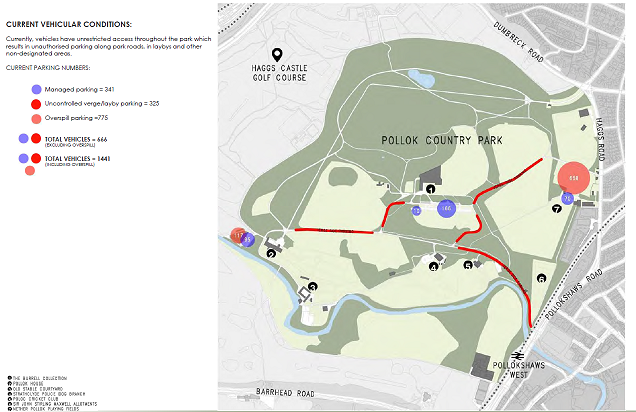
Key. Red line mark verge parking. Blue discs = formal car parks. Red discs = “over-spill”.
It has for many years been impossible to park along the verges as depicted. There are only a handful of parking bays on the roads marked in red and to represent verge parking as allowing 325 places appears to be a gross exaggeration (the largest verge parking in the park takes place by the allotments at the Dumbreck Rd entrance and may involved c20 vehicles).
The proposal retains the Pollok House and Burrell car parks as they are at present and adds a large new car park on the Blaes pitches. This increases the “managed” car parking from 341 to 566 places, a huge increase. Almost all the apparent reduction of parking places is achieved by reducing the 658 “over-spill” places at the Blaes to 320 places. Since that space is rarely used outside of sporting events, in real terms the proposal represents a massive increase in cars entering the park. That should be cause for a re-think.
If a shuttle bus was up and running, it would be possible to remove all the car parking capacity for the general public except for a number of disabled/reduced mobility parking spaces at Pollok House, the Burrell and the Blaes pitches. With much reduced car parking there would be no need to create a new road to the Burrell or improve the Hagg’s Rd exit/entrance.
While it is appreciated that the car park at Pollok House is now controlled by the National Trust for Scotland, they as an organisation are committed to environmental objectives and there is no reason why they should not be asked to re-think how that car park is used, taking account of the needs of elderly volunteers who keep Pollok House going.
A consequence of maintaining a total ban on vehicles used by the general public might be an increase in the number of cars parking in areas neighbouring the park or people trying to access private resident’s car parks. This could to an extent be addressed through Traffic Regulation alongside improved public transport connections that encouraged car owners to leave their vehicles elsewhere.
A compromise solution, which would be in accordance with aspirations to keep vehicles out of the park, would be to close the Burrell and Pollok House car parks but create a smaller new car park at the Blaes site by Hagg’s Road as proposed. A small car park might work if most places were reserved for people with disabilities and charges for the remaining places were set at a level to encourage the public to arrive by public transport, foot or bicycle.
Cycling and pedestrian proposals
The depiction of current cycle and pedestrian use of the Country Park in the application is misleading and the proposals sadly lacking in ambition, given the very high levels of use during the corona crisis.
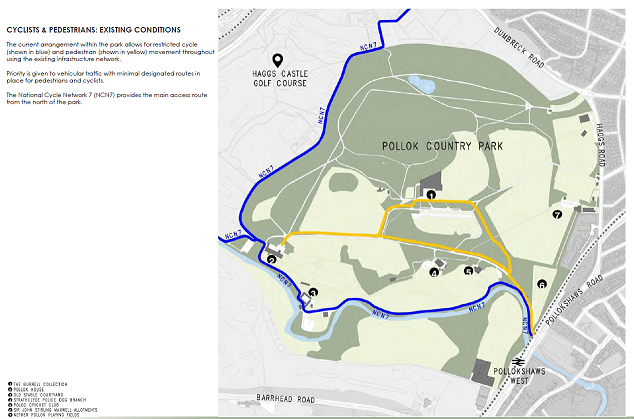
Blue = National Cycle Routes Yellow = pedestrian
Existing use is portrayed in the Application as the National Cycle Route, while the majority of the pedestrian routes depicted are along the road (only the section from near the Pollokshaws entrance to the Burrell is currently a footpath). This is highly misleading. For example, the access from Titwood Rd via the road that leads round to Pollok House has always been heavily used by cyclists and walkers. That route is depicted by the blue dotted line on the map of proposed routes:
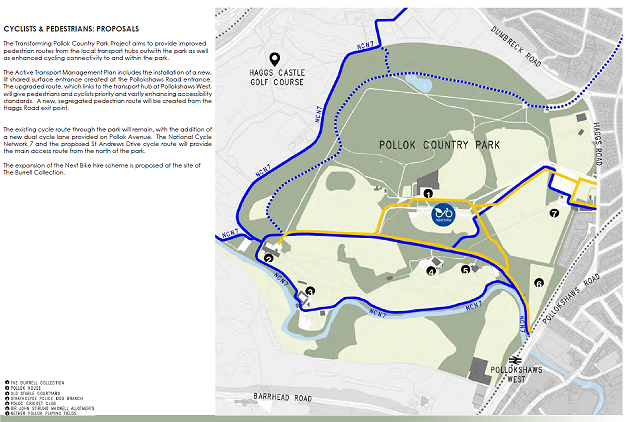
In fact, all the so-called proposed routes are already effectively there and the application adds nothing to the existing path infrastructure in Pollok Park.
What is doubly disappointing is that the application does not describe how these “new” path networks might be better linked to public transport and other paths outwith the park, except for the extension of the South West city way along St Andrew’s Drive to the Titwood Road entrance. With traffic returning to the roads, the challenge is how the Council can ensure that people have safe cycle routes to access the park from a number of different directions.
The South West Community Cycles bike hire at Pollokshaws West station represents a resource which could potentially be extended to allow people with mobility issues to hire electric caddies. There is also potential to add Next Bike hire point at Dumbreck Station, connecting to the National Cycle route, and by the main entrance to the park.
The Planning documents refer to new cycle shelters at two locations but only three bays of five between them. Given the huge increase in people cycling to the park, that it totally inadequate. For example, people have been chaining their bikes to the railings at the lodge by the St Andrew’s Rd entrance because there is nowhere else to secure them. All the main entrances/exits and the main attractions should have cycle racks located nearby.
Design of the proposed new car park and new road
The proposed car park appears ugly, with nothing to soften its impact on the surrounding landscape. It represents the suburbanisation of what is supposed to be a country park. There is not a scrap of vegetation in the designs, when even shopping centres and supermarkets make an effort to plant a few trees and shrubs. There will be no shade from the sun, just an intrusive mix of coloured tarmac in yellow, grey, green and blue. A large number of standard road signs are also planned, adding to the sense of it being out of place.
The choice of kerbs is poor. It is not clear from the application whether it is proposed to these extend into the park itself and not just the new car park. They are sharp, clean-lined and urban and inappropriate for a country park.
There is a proposal to install urban street lighting all the way to the Burrell, which is horribly out of place for a country park. Over 60 stainless steel light poles, each over 4 meters high are marked on the drawings.
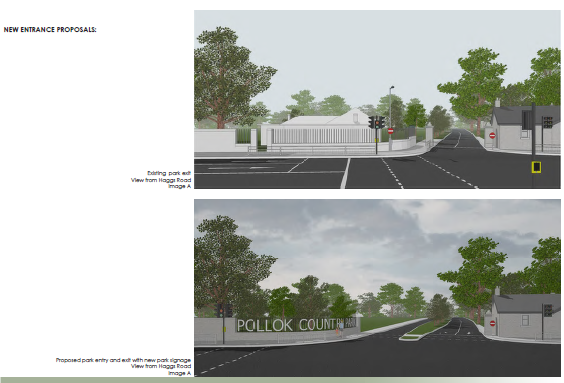
The proposed alterations to the entrance way at Hagg’s Road are destructive, making it look suburban or corporate and dominated by the road. By contrast the current narrow entrances give the feel that you are going somewhere different, that you are entering a park. Moving the entrance pillars is unfortunate, as has been commented on by Historic Environment Scotland.
The cycling and pedestrian access by this entrance appears to be designed round cars. The widening is to cater for an increased volume of traffic. The shared path detours away from the road and cyclists and people walking will be directed to cross through the new car park. It is wrong to make people cross two car lanes and negotiate cars parking, to access a country park.
If the amount of car parking was reduced, as suggested here, there would be no need to for an enlarged three lane entrance. One lane in and one lane out would be fine.
The design of the car barriers at various points within the park is suitable for an out of the way industrial estate, not a country park. They are forbidding, authoritarian and ugly.
Other new infrastructure includes huge new battery installations, 7m long and industrial metal in style. One is at the Burrell car park and another near the new Haggs Road car park. There is no real explanation what they are for and no attempt to disguise them.
Conclusion
This whole project, under the guise of being green, risks further urbanising the country park which is effectively the last remnant of an historic rural area/designed landscape and is now surrounded by intense pressure from housing, industry and roads. Pollok Park has become a haven during the corona crisis and the last thing that is needed is for all the signifiers of an unsustainable urban life being brought like an unwelcome guest into the park landscape. People have talked about a new start for Scotland after Covid-19. This is not it.
If you agree, please consider objecting to the planning application (see here).
Among the key points you could make in objecting to the application are:
- The corona crisis has had a transformative effect on the use of the park and shown what is possible. It has shown that a drastic reduction in parking within the park is not just desirable but possible. It would be extremely unfortunately if this planning application undoes the gains of the last three months.
- The blaes pitches is a reasonable location for a car park but only if other managed car parking is removed.
- If that happened and the blaes car park was reduced in size, there would be no need to widen the entrance as proposed or construct a new road to the Burrell
- The design of the car park and the associated infrastructure of lighting etc is not appropriate for a country park.







 #b
#b














While many people are undoubtedly now visiting on foot and by bike, many are also coming by car. In lieu of car parks, they are using Titwood Road, Haggs Road etc, for on-road (and on-pavement) parking. This is not ideal either, especially for local residents.
PS I haven’t read the proposals yet in detail, but wanted to make sure the current consequences of having no car parks are noted.
Not a good idea. I have never met anyone who has been put off by the park, th Burrell or Pollok House being difficult to access. This will spoil the park.
Yes i concur with the above comment –since the lockdown we have seen St Andrews Drive rammed with cars which previously would have been parked inside Pollok Park. And as much as i am in favour of bikes it has become hazardous walking with small children in Pollok Park as cyclists roar up and down at speed.